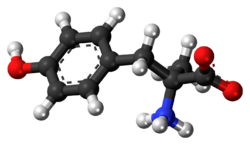Chemistry:Metirosine
 | |
 | |
| Clinical data | |
|---|---|
| Trade names | Demser |
| AHFS/Drugs.com | Consumer Drug Information |
| ATC code | |
| Pharmacokinetic data | |
| Elimination half-life | 3.4–3.7 hours |
| Identifiers | |
| |
| CAS Number | |
| PubChem CID | |
| IUPHAR/BPS | |
| DrugBank | |
| ChemSpider | |
| UNII | |
| KEGG | |
| ChEMBL | |
| Chemical and physical data | |
| Formula | C10H13NO3 |
| Molar mass | 195.218 g·mol−1 |
| 3D model (JSmol) | |
| |
| |
| | |
Metirosine (INN and BAN; α-Methyltyrosine, Metyrosine USAN, AMPT) is an antihypertensive drug. It inhibits the enzyme tyrosine hydroxylase and, therefore, catecholamine synthesis, which, as a consequence, depletes the levels of the catecholamines dopamine, adrenaline and noradrenaline in the body.
Clinical use
Metirosine has been shown to suppress catecholamine synthesis and alleviate symptoms related to catecholamine excess, including hypertension, headache, tachycardia, constipation, and tremor.[1] Metirosine is primarily used to reduce these symptoms in patients with pheochromocytoma.[2] It is contraindicated for the treatment of essential hypertension.
However it is now rarely used in medicine, its primary use being in scientific research to investigate the effects of catecholamine depletion on behavior.[3] There is evidence that catecholamine depletion causes an increase in sleepiness that is more pronounced than sleep deprivation, and that the fatigue lingers after the drug is discontinued. Negative mood is also a reported side effect of catecholamine depletion, although this is reported less consistently than sleepiness.[4]
See also
- p-Chlorophenylalanine
References
- ↑ Naruse, Mitsuhide; Satoh, Fumitoshi; Tanabe, Akiyo; Okamoto, Takahiro; Ichihara, Atsuhiro; Tsuiki, Mika; Katabami, Takuyuki; Nomura, Masatoshi et al. (2018). "Efficacy and safety of metyrosine in pheochromocytoma/paraganglioma: a multi-center trial in Japan". Endocrine Journal 65 (3): 359–371. doi:10.1507/endocrj.EJ17-0276. ISSN 0918-8959.
- ↑ "Alpha-methyltyrosine in the management of phaeochromocytoma". Thorax 37 (8): 632–3. August 1982. doi:10.1136/thx.37.8.632. PMID 7179194.
- ↑ O'Leary, OF; Bechtholt, AJ; Crowley, JJ; Hill, TE; Page, ME; Lucki, I (2007). "Depletion of serotonin and catecholamines block the acute behavioral response to different classes of antidepressant drugs in the mouse tail suspension test". Psychopharmacology 192 (3): 357–71. doi:10.1007/s00213-007-0728-9. PMID 17318507.
- ↑ McCann, Una D.; Penetar, David M.; Shaham, Yavin; Thome, David R.; Sing, Helen C.; Thomas, Maria L.; Gillin, J. Christian; Belenky, Gregory (June 1993). "Effects of Catecholamine Depletion on Alertness and Mood in Rested and Sleep Deprived Normal Volunteers". Neuropsychopharmacology 8 (4): 345–356. doi:10.1038/npp.1993.34. ISSN 0893-133X.
 |

